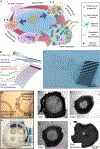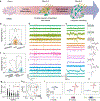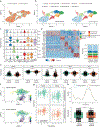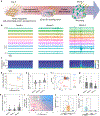Stretchable Mesh Nanoelectronics for 3D Single-Cell Chronic Electrophysiology from Developing Brain Organoids
- PMID: 35014735
- PMCID: PMC8930507
- DOI: 10.1002/adma.202106829
Stretchable Mesh Nanoelectronics for 3D Single-Cell Chronic Electrophysiology from Developing Brain Organoids
Abstract
Human induced pluripotent stem cell derived brain organoids have shown great potential for studies of human brain development and neurological disorders. However, quantifying the evolution of the electrical properties of brain organoids during development is currently limited by the measurement techniques, which cannot provide long-term stable 3D bioelectrical interfaces with developing brain organoids. Here, a cyborg brain organoid platform is reported, in which "tissue-like" stretchable mesh nanoelectronics are designed to match the mechanical properties of brain organoids and to be folded by the organogenetic process of progenitor or stem cells, distributing stretchable electrode arrays across the 3D organoids. The tissue-wide integrated stretchable electrode arrays show no interruption to brain organoid development, adapt to the volume and morphological changes during brain organoid organogenesis, and provide long-term stable electrical contacts with neurons within brain organoids during development. The seamless and noninvasive coupling of electrodes to neurons enables long-term stable, continuous recording and captures the emergence of single-cell action potentials from early-stage brain organoid development.
Keywords: bioelectronics; brain organoids; electrophysiology; nanoelectronics; neural interface; stretchable electronics.
© 2022 Wiley-VCH GmbH.
Conflict of interest statement
Conflict of interests
The authors declare no financial or commercial conflicts of interest.
Figures





Similar articles
-
Emerging Bioelectronics for Brain Organoid Electrophysiology.J Mol Biol. 2022 Feb 15;434(3):167165. doi: 10.1016/j.jmb.2021.167165. Epub 2021 Jul 19. J Mol Biol. 2022. PMID: 34293341 Free PMC article. Review.
-
Cyborg Organoids: Implantation of Nanoelectronics via Organogenesis for Tissue-Wide Electrophysiology.Nano Lett. 2019 Aug 14;19(8):5781-5789. doi: 10.1021/acs.nanolett.9b02512. Epub 2019 Aug 2. Nano Lett. 2019. PMID: 31347851
-
Cyborg organoids integrated with stretchable nanoelectronics can be functionally mapped during development.Nat Protoc. 2025 Mar 26. doi: 10.1038/s41596-025-01147-7. Online ahead of print. Nat Protoc. 2025. PMID: 40140634 Review.
-
Mesh Nanoelectronics: Seamless Integration of Electronics with Tissues.Acc Chem Res. 2018 Feb 20;51(2):309-318. doi: 10.1021/acs.accounts.7b00547. Epub 2018 Jan 30. Acc Chem Res. 2018. PMID: 29381054 Free PMC article.
-
Stretchable mesh microelectronics for the biointegration and stimulation of human neural organoids.Biomaterials. 2022 Nov;290:121825. doi: 10.1016/j.biomaterials.2022.121825. Epub 2022 Sep 30. Biomaterials. 2022. PMID: 36326509 Free PMC article.
Cited by
-
Emerging Bioelectronics for Brain Organoid Electrophysiology.J Mol Biol. 2022 Feb 15;434(3):167165. doi: 10.1016/j.jmb.2021.167165. Epub 2021 Jul 19. J Mol Biol. 2022. PMID: 34293341 Free PMC article. Review.
-
Integrating single-cell transcriptomics with cellular phenotypes: cell morphology, Ca2+ imaging and electrophysiology.Biophys Rev. 2023 Dec 18;16(1):89-107. doi: 10.1007/s12551-023-01174-2. eCollection 2024 Feb. Biophys Rev. 2023. PMID: 38495444 Free PMC article. Review.
-
3D Spatiotemporal Activation Mapping of Cardiac Organoids Using Conformal Shell Microelectrode Arrays (MEAs).Res Sq [Preprint]. 2025 Feb 7:rs.3.rs-5939602. doi: 10.21203/rs.3.rs-5939602/v1. Res Sq. 2025. PMID: 39975924 Free PMC article. Preprint.
-
Temporal and spatial omics technologies for 4D profiling.Nat Methods. 2025 Jul;22(7):1408-1419. doi: 10.1038/s41592-025-02683-6. Epub 2025 Apr 22. Nat Methods. 2025. PMID: 40263585 Review.
-
Brain organoids: building higher-order complexity and neural circuitry models.Trends Biotechnol. 2025 Jul;43(7):1583-1598. doi: 10.1016/j.tibtech.2025.02.009. Epub 2025 Apr 12. Trends Biotechnol. 2025. PMID: 40221251 Free PMC article. Review.
References
MeSH terms
Grants and funding
LinkOut - more resources
Full Text Sources

